“I didn't even know the Summer of Love was happening. I was too busy playing with me Action Man.” - Sid Vicious
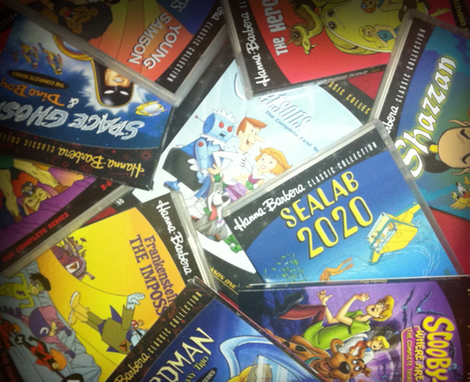
Be it sad or wonderful, one of my earliest childhood memories was gazing fixedly into my parent’s black & white television set, way back in the summer of 1967. Our family was living in heart of the San Francisco Bay area right in the midst of the so-called “Summer Of Love”. Yep, stoned hippies and flowers everywhere. Thankfully I was blissfully unaware of this laughable chapter in human silliness. So while Sid was fiddling about with his Action Man in ol’ Blighty, I was coveting a GI Joe Action Soldier in Frisco. As the blossom-sotted summer was on the wane and the hippies were munching on their last lysergic blotters in Golden Gate Park, my li’l five-year-old mind was trembling anticipation of this fateful date;
September 9th
I may not have known my own birthday at that age, but boy did I remember September 9th. Why? Because that’s when the deep gravelly voice on KCBS told me the new Saturday morning cartoon season would begin! And what enriching entertainment faire would crammed into my impressionable mind? Why this kind of marvelous rubbish;
Frankenstein Jr
The Impossibles
Hercuoids
Shazzan
Space Ghost
Moby Dick
Mighty Mightor
And that was only on ONE of the networks! Spaceships, vile aliens, explosions, superheroes, ugly villains, explosions, laser beams and still more explosions! All of the comic book violence and sci-fi melodrama a growing towheaded boy could want. Superhero-mania had come to Saturday morning and my five-year-old mind was deep in its grip. There was a short moment in the sun for li’l preschool dolts like me that Saturday morning television programming was filled with such delightfully-moronic, superhero-infested goodness.
But, like all good things it came to a premature end. Thanks to ugly conflict in Southeast Asia bringing war home to our televisions every night, suddenly violence was deemed taboo, especially for us impressionable youngsters. So a cabal of overly-protective mommies sought to eliminate aggressiveness at its fount. These do-gooding neo-Carrie-Nations hurled their axes toward television, especially children’s programming. They called on the networks to eviscerate the violent content from kiddie shows under the delusion that it would make us rugrats into nice, obedient and non-hostile kiddies. Precipitously the networks caved-in to such pressure and started sanitizing their Saturday morning cartoons. In the blink of a single season the Hanna-Barbera superheroes Shazzan, Space Ghost, Mightor and even the venerable Herculoids family were all sent packing and replaced with less threatening doggerel like The Archies and Whacky Races. By 1969 the superheroes were completely extinct and a humble show called Scooby Doo-Where Are You set the tone of Saturday Mornings. Of course it only got worse when these hippy mommies then forced the cartoon makers to interweave non-violent morality lessons into their shows. To top it off, they tried to get rid of the cartoons all together and substitute them with more live-action kiddie programming. So dope-influenced crap like H.R. Puffinweed, Lidsville and The Bongaloos stunk up the Saturday mornings of the stoned generation of the seventies. But by that time I was pretty much past the cartoons stage anyway and found a new love in The Beatles just as I entered into my teens.
However this curious period of my life was sitting in the ‘neither fully remembered, nor fully forgotten’ file until I happened upon a scan of this comic-book advert back in 90s trumping the “Saturday’s Super Heroes” line-up. Suddenly it all came flooding back.
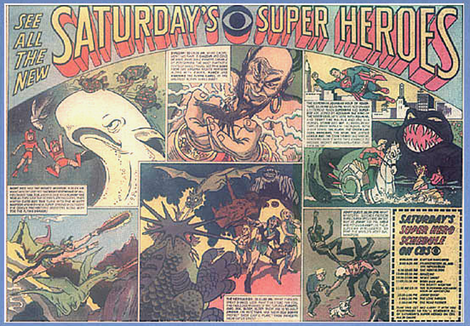
Most comical, pardon the pun, is how misrepresented the shows are, making Shazzan look like an evil demon and Moby Dick appear to rather nefarious too, when in fact they were the benign protagonists of those shows?
Be Careful What You Wish For
A decade ago I would have done horrible things to kittens for the chance to see a few of those silly old cartoons from 1967 again. Some years ago I remember buying a costly bootleg version of some Herculoids episodes that I never got to work in any DVD player. And aside from sources on the darker side of the net, these shows were commercially unavailable - and even if they were they were often of very poor quality, typically cruddy VHS transfers or worse. I did have better luck with a shady-market copy of Luno The Flying Stallion, but I gave up at that point trying to get ahold of these ancient cartoons.
Then a curious phenomenon came along early in the new millennium called Adult Swim. Suddenly it was hip to use these dreadful 60s cartoons as fodder for satire. These old superhero shows were reformulated into comedies. The biggest success was the strange transformation of Space Ghost into a cartoon talk-show host, then Sealab 2020 episodes get re-dubbed with droll dialogue and Birdman passes the Bar and gets turned into a series of in-jokes about various old Hanna-Barbera cartoons. Even with modern computerized techniques, the style remained faithful to the originals - especially the stilted animation. In general these new comic variations on old shows are hit or miss, most of the time miss. However good or bad they are, the Adult Swim shows served as a catalyst to bring back the original cartoons back from cold storage.
The media giants, chiefly Warner Bros, must have realized there was a sizable market for similarly addled forty-somethings who would pay real money to watch poorly animated garbage from the days of yore. And soon Warners cobbled some nostalgia-infused sets featuring compilations of Saturday morning cartoons from the 60s, 70s and 80s. Alas the stuff I wanted to see was poorly represented in these sets, wedged between more famous cartoons like Top Cat and Quick Draw McGraw. I can only assume enough middle-aged consumers yowled at Warner Bros to re-issue these cartoons as complete series as they did just that. Of course WB charged a premium for these sets, but it was fun to see them again. And since I had been granted something I never expected to see again, I ate them up ravenously.
Yet, like wolfing a jumbo bag of potato chips, after a while it leaves you feeling gorged with an excess of greasy nothingness. This point was driven home when I flubbed for a set of Groovie Ghoulies episodes on DVD. Despite of any fondness I had for the Groovie Ghouliles back then, I found these shows so astoundingly awful that I swore off any more purchases back into childhood nostalgia. So with the notion that my archive of this stuff is now closed, I thought I’d prattle about these curious products of Hanna-Barbera with the jaundiced eye of a fifty-year-old twit.
Meet Your Makers

Hanna-Barbera Studio Building, Studio City, CA
During the early late fifties the Hanna-Barbera studio had realized the days of cartoons at the local cinema were numbered. So in the early sixties they staked their claim on television, creating a string of animated shows which were generally patterned after famous television series and/or performers. Probably best known for their redux of the Honeymooners, called The Flintstones, Hanna-Barbera’s animation was simple, stylized and memorable for several reasons. First, the characters were distinctive-looking and were brought to life with good voice performers (often imitating famous actors). Though the plots weren’t nearly as witty as the Warner Brothers cartoons of yore, they were still enjoyably predictable. But they were past masters at incorporating memorable catch-phrases which their characters employed on a frequent basis during each show (from “Exit Stage Left Even” to “Yabba Dabba Do”).
Since the animation was very stylized, it was relatively inexpensive and quick to create these toons and the studio soon dominated the Saturday morning lineup with light-hearted kiddie fare with an emphasis on slapstick. But things would change significantly by the mid-sixties. Mostly due to the popularity and influence of the Batman television program. Hanna-Barbera decided to create some cartoons based on comic book hero archetypes. But to accomplish this, the stylized characterization of earlier shows had to be dropped. Animating heroic human characters with an emphasis on physical realism simply could not be done with the same efficiency of animating Huckleberry Hound. So the animation in these hero-themed cartoons is pretty stilted, almost painfully so. But to a five-year-old boy’s mind, I didn’t care, they caught my imagination and I continued to have happy memories of these silly shows for much of my adult life.
Then within the last few years I was able to re-experience these shows almost forty five years after their original broadcast (and with a mind ten times older then when I viewed them originally!). In most ways it was a case of ‘to think I was once impressed by this stuff?’ when I watched these old programs. So it’s easy to be harsh on the feeble animation, but I tried to keep in mind the Hanna Barbera studios had to churn out different cartoon shows by the bushel and on a very slim television budget to boot. And above it all, you have to remember that Saturday morning was nothing more than an early bit of promotional synergy, so child-oriented products, food and toys could be marketed to a rapt audience of kiddies.
Most of Hanna-Barbera’s cartoons were broken up into short segments, often as different ‘mini-shows’. I’m sure this was to keep costs down, but it also probably suited the increasingly short attention span of 60s youth - especially when your five-year-old body is jacked up on several brimming bowls of Froot Loops or Cap’n Crunch.
Now, before we get into my humble appraisals, I should say this is not intended to be a complete guide - obviously - as I just want to comment on a few of the shows that captured my stupid little preschool mind back in the mid-sixties.
Space Ghost & Dino Boy 66-67
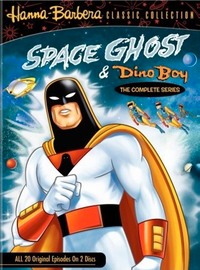
For two years this show was the king of Saturday morning and by 1967 had changed the landscape of Saturday morning to an superhero-oriented line-up. Obviously a derivative design of Batman, Space Ghost was a no-nonsense, lantern-jawed hero with two teenage sidekicks and a little monkey called Blip (Blip sounds like it’s ‘voiced’ by a doggie’s chew-toy). Set somewhere in outer space, our four heros are on the prowl 'round galaxy. Usually the two teens get into some kind of jam which would require Space Ghost to effect a rescue. The stories often involved an invasion by nefarious aliens, super villains and/or robots, which Space Ghost would zap with a bewildering array of weapons in his wrist-bound ‘power bands’ until the baddies were destroyed or retreated at the end. And each ‘story’ was infused with a generous number of explosions of course. The heros fending off invaders theme was standard for many of these mid-sixties cartoon shows, perhaps a reflective of the fifties cold-war xenophobia that was still pervasive in the sixties.
Like any comic book tale, there were recurring villains, which always managed to slither away in the end. Mr. Ghost was bedeviled by Metallus, Zorak and Spider Woman, amongst others. Probably the best show in the series is the two-part episode “Council Of Doom” which has Space Ghost encountering other Hanna-Barbera superheroes. I’m assuming it was created as a kind of promotional segment?
Sandwiched between the two Space Ghost segments in each show was the awful Dino Boy segment. Dino Boy featured an irritating little kid (voiced by a lad named Johnny Carson [no relation]) living with a grunting, monosyllabic caveman. They shared their adventures around a mysterious prehistoric world with a pet Brontosaur that sounded exactly like Scooby-Doo did a couple of years later. These Dino Boy shows are so unappealing I’m surprised someone has given it the Adult Swim treatment.
The Herculoids 67-68
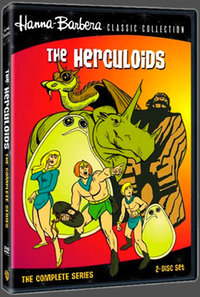
This show left the biggest impression upon my five-year-old brain, but I’m not really sure why. Set on a futuristic, yet primitive planet, the cookie cutter plots have the Herculoid family fending off rapacious invaders. Lead by Zandor, his fellow Herculoids consist of his wife, son and a group of monster-like pets. The most curious in the Herculoid menagerie are the Shmoo-like Gloop and Gleep, that can reform their shapes like globs of Play Doh. One novelty about the Herculoids is that it was one of the few Hanna-Barbera shows that was not paired with another show. Instead, each show consisted of two 10-minute episodes, instead of the typical 7-minute segments of most of these cartoon shows. But the truth is it didn’t make any difference, there was little more in the way of plot or subtext, just the standard heros-versus-invaders byplay.
The surreal planet the Herculoids live upon is the most appealing part of the show, and most of the invading baddies are of the sci-fi variety. Like many other shows of this time, it was designed by masterful Alex Toth, and if anything the Herculoids stands out for a few reasons. To begin with, it actually features a family, whom save for some weapons proficiency don't have superpowers. Since the three humans don’t have special powers they chiefly rely upon their creatures to do the heavy work. Zok, Tundro, Igoo and the blob-like Gloop and Gleep are featured in the climatic battle in every episode, deploying their arsenal against the baddies. With all the goofy superhero films today I’m surprised that the Herculoids haven’t been modernized and thrown onto the big screen.
Frankenstein Jr & The Impossibles 66-67
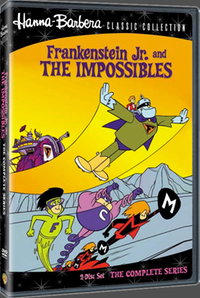
This should have been called The Impossibles & Frankenstein Jr, as the Impossibles get two segments per show and Frankenstein Jr gets only one. The Impossibles are a Beatles-esque rock combo that fights crime on the side. Each Impossible can change into his superhero form; a coiled-spring (Coil Man), a replicator (Multi-Man) and a liquid-transformer (Fluid Man). Each show begins and ends with the pop-group giving a concert, while the bulk of the show has them chasing down a comical criminal. The songs are prime examples of Hanna-Barbera's shameless ripoffs (OK, let's say "parodies") of pop tunes, but still manage to be vilely catchy. Just like the horrible pop songs in the second season of Scooby Doo, the Hanna Barbera pop tunes haven't aged terribly well.
A bit more satisfying is the Frankenstein Jr segment. Featuring Ted Cassidy (known to most people as Lurch from the Addams Family TV series) as the voice of Frankenstein Jr, a massive robot with multiple abilities. He’s controlled by a young boy-genius, Buzz, who flies off with the giant robot to fight crime. Buzz’s father monitors their progress, while pensively holding his pipe, from their futuristic home/headquarters atop a mountain. Because the stylized animation has less focus on realism, it winds up being a bit more fun than the straight-faced super hero shows, The villains tend to be too silly to be much of a threat, but obviously this show was not designed for the appeal as Space Ghost and Mightor.
Moby Dick & Mighty Mightor 67-68
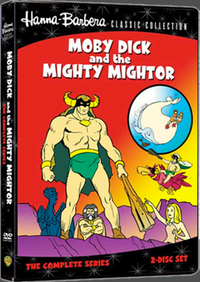
Following the three-segment formula, each episode features two Mightor segments and one Moby Dick story. Mightor lives on some prehistoric world and fights off villains who threaten his family’s village. He’s a scrawny teenage boy named Tor who transforms into a hulking superhero by uttering "Mightor". In that form Mightor flies around with a powerful club and a dragon-like pet. Apparently the show began as Mighty Thor, based on the Marvel comics hero, but was transmogrified into Mightor for reasons expounded upon in Wikiland. Many of the episodes features an irritating little Mightor-wannabe kid that flies around on a dodo and in his teen form Tor exchanges barbs with his fickle girlfriend Sheera. Generally the shows stick the primitive theme, most of the invaders are not the standard xenophobic robots/aliens themes of their companion cartoons.
Moby Dick is the story of two young boys, Tub and Tom, who spend much of their time wallowing around the ocean in spacesuit-like swimming costumes, getting into trouble until their friend Moby Dick, a nice version of the white whale, comes to save them. Often accompanying the lads on their aquatic adventures is a seal called “Scooby”. The shows are pretty weak, not too fun and the kids are not appealing, in fact are like the irritating lad in Dino Boy, rather unsympathetic and grating at times. The underwater world they live in is also uninspired, and one gets the feeling not much time was spent developing this segment. No explanation is given to where these kids manage to survive or even eat/drink out in the open ocean, so I’ll just assume they munch seaweed whenever possible.
Space Kiddettes & Young Samson 66
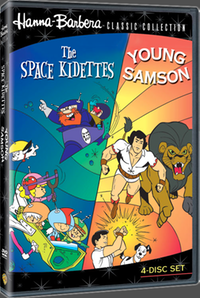
This show was atypical as it featured a stylized, lighthearted show paired with a more realistic superhero show. The Space Kiddettes were a group of children living an a clubhouse made from a space capsule. They are threatened by a pair of bumbling villains who try to steal their secret treasure. The animation is more enjoyable as it’s less stilted than the superhero adventures of Samson and I enjoy the childlike hi-jinx and the stylized Googie-outer-space backgrounds. The kids are generally appealing and the pre-school plots are a welcome relief from the heros vs invaders that permeates most of these shows.
Young Samson is the superhero counterpoint to the little Kiddettes. Like Mighty Mightor, Samson is a teenager who can transform himself and his pet into a superhero form (and that formula was regurgitated into the 80s with the Filmation He-Man cartoons). He also shares an attribute with Space Ghost in that his super powers come from bands around his wrists. But the Samson segments are pretty bare bones, with the most limited animation of any of the superhero shows. Samson is voiced by a young Tim Matheson (who also did voices for Space Ghost’s Jason character) who went on to be a successful movie and television actor. On the whole the minimal animation ruins the Samson episodes, being so stilted it kills any suspense in the basic story. Alas the Space Kiddettes and Young Samson only lasted a single season, where most of the shows mentioned here were made it through two.
Birdman & The Galaxy Trio 67-68
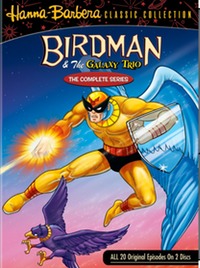
The Birdman shows are almost unwatchable simply because of the exceedingly shrill “Bird-Man!” phrase that the hero sings out constantly. Birdman is a superhero with an Achilles heel, he can’t be out of the sunlight for very long or he loses his superpowers. He’s assisted by an eagle mascot, called Avenger, who often saves Birdman’s bacon after he’s been drained of his powers by shunted from the sun. But Birdman is so stolid and humorless that there’s not much to care about - and that damned “Bird-Man” yowl makes the show a trial to watch. Ironically this show made a very successful transition to the Adult Swim world, and the Harvey Birdman Attorney At Law is a skillful parody and a witty homage to these Hanna-Barbera glory days.
A bit better than the original Birdman shows are the The Galaxy Trio, a group of young, colorfully-skinned humanoids who save the universe from evil in each episode. While less irritating than the Birdman shows, they’re also just another variation on the Space Ghost formula, with a dash of Star Trek thrown into the bargain. It’s a wonder that they Hanna-Barbera staff were able to keep inventing a never-ending series of power-hungry villains for these space-bound heros to fight. But after Space Ghost and The Herculoids baddies, these Galaxy Trio villains are laughably derivative, and weak animation makes the shows only mildly interesting. I'm surprised this show lasted two seasons.
Shazzan 67-68
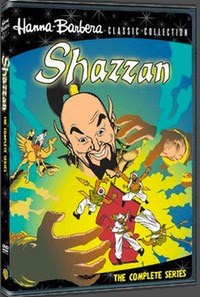
This show was one of the stragglers to DVD, but finally emerged in early 2012. Shazzan was notable for being one of the few superhero shows that wasn’t set in outer space or on some quasi-prehistoric world. Two teen siblings, Nancy and Chuck, are teleported back to the mythical days of Arabian nights and can summon a gigantic genie called Shazzan by putting their interlocking rings together. They ride a flying camel called Kaboobie (who's voice is a precursor to Scooby Doo's) and get into jams of one sort or another. Then the big genie gets them out of whatever scrape they’ve become embroiled with and dishes out absolution to the meanies. Which only means the kids get into another scape until Shazzan "Ho-ho-ho-ho's" their way to safety. The series follows the Herculoids template of being two 10-minute episodes and are a little more enjoyable than most of the other superhero shows simply because it’s not a standard ‘destroy the invaders’ plots. Instead we’re given variations on a theme of cliche evil characters in this mythic arabian world. The animation is a lot like all the other Hanna-Barbera shows, but sometimes the exotic locations rise above the norm. So Shazzan aims high but is addled by it's double-plots and sometimes threadbare animation, but overall the shows still are enjoyable.
Epilogue & Fade Out - Space Stars 1981
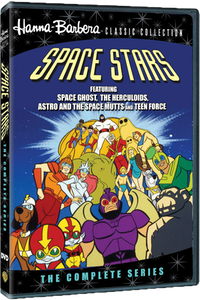
By the time the 80s dawned, Hanna-Barbera had resurrected some of the heroes of the sixties in the form of Space Stars. Both Space Ghost and the Herculoids were featured in each hour-long episode, along side the Teen Force and several others. Though the stories are just as mindless as their shows from fifteen years before, they are so infused insipid messages and droll educational segments that it spoils any entertainment value. In the old days Space Ghost would just have blown the aliens up, now they are talked into submission until they leave peacefully. Of course by the time these shows had aired, I was in college, so I was happily unaware of them, only as an archival item did I become aware of their existence.
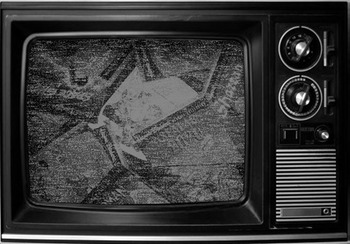
Looking back at this stuff I’m amazed how entertaining it still is to my foolish old mind. In many ways these were the glory days of a weird chapter in pop-culture, before regulation brought down the fun factor - and by the eighties the Saturday morning cartoon was going the way of the dodo. By the nineties we were shackled into the 500-channel universe, with its panoply of cable networks. By the new millennium there were several cartoon-themed channels and a new genre emerged, adult-oriented cartoons. So now days you can live cartoons 24-hours-a-day and wallow in animated garbage that makes these sixties-era Saturday Morning shows seem as sophisticated as Voltaire. But those Saturday morning satires were the shows that helped, in their own way, bring back these olde shows. Warner Brothers obviously has latched on to a good thing with these MOD releases, as they keep offering more and more old shows to dolts like me who will shell out primo dinero for the right to own them. Of course to fully relive these times you’d need to infuse these toons with lots of commercials for breakfast cereal, candy, toys - especially war toys - and all the other stuff that made Saturday morning an effective marketing mechanism for corrupting little consumer’s minds. And thus corrupted, I suppose I can call myself a happy ‘victim’ of this animated nonsense.
